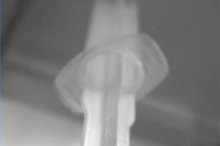How to Clean a Feeding Tube
A percutaneous endoscopic gastrostomy tube, more commonly referred to as a PEG tube, is used to feed a person or to administer medications and liquids 1. While a PEG tube can last for several months or even years, they can become damaged or clogged over time, according to the American Society for Gastrointestinal Endoscopy (ASGE). Because one end of the tube is inserted surgically through the skin and placed inside the stomach, proper care of the tube is necessary to keep the tube clean and from becoming clogged with food or medicine.
Wash your hands for at least 2 minutes before cleaning the PEG tube equipment. Clean hands help to prevent infection.
How to Unclog a G-Tube Feeding Tube
Learn More
Flush the feeding tube with warm water if it becomes clogged 2. During the first 24 hours after the tube is put in, flush the tube with 45 to 60 cc of water every 4 hours to keep the tube from being blocked. After the first 24 hours, start by putting only water in through the tube before feeding or administering medication 2. Use a catheter-tip syringe to push clean, warm tap water into the feeding tube 2. Larger syringes, greater than 35 ml in size, are better. Insert the syringe into the open end of the tubing. Keep the tube open and clean by flushing the tube both before and after every feeding or administering medication 2. This usually requires pushing through one or two syringes of water.
Wash the tubing in hot, soapy water after every feeding. Rinse in hot water and then wrap in a clean towel. Store the wrapped tubing in the refrigerator between feedings to slow the growth of bacteria. Wash tubing in hot water again after the last feeding of the day before rinsing with a solution of ¼-cup vinegar mixed in 1 cup of water 2. Rinse tubing in hot water and wrap in a clean towel or store in a sealed plastic bag before refrigerating.
How to Use Fleet Enemas Prior to a Prostate Biopsy
Learn More
Take the syringe apart and wash it in hot, soapy water so that you can reuse it. Rinse the syringe thoroughly with hot water, and then allow it to air dry. Change syringes at least twice each week.
Push cola through the tube once each day using a syringe. The carbonation in the cola helps to keep the tube clean by dissolving residue left by food or medication. Afterward, flush the tube with water. Another alternative is to use seltzer water instead of cola. Use an extra long pipe cleaner to clear the inside of a clogged feeding tube 2. You can also use the dull side of a table knife to clean the tube. At the same time that you are flushing the tube with water, run the knife along the outside of the feeding tube in the same direction that the water is flowing 2. The method is similar to that of curling ribbon.
Tips
Check the tubing frequently for cracks or leaks.
Related Articles
References
- Endoscopic Procedures
- Living with a Feeding Tube
- Sullivan SN. Functional abdominal bloating with distention. ISRN Gastroenterol. 2012;2012:721820. doi:10.5402/2012/721820
- The Oral Cancer Foundation. Nutrition/feeding systems.
- Philpott H, Garg M, Tomic D, Balasubramanian S, Sweis R. Dysphagia: Thinking outside the box. World J Gastroenterol. 2017;23(38):6942–6951. doi:10.3748/wjg.v23.i38.6942
- Blumenstein I, Shastri YM, Stein J. Gastroenteric tube feeding: techniques, problems and solutions. World J Gastroenterol. 2014;20(26):8505-24. doi:10.3748/wjg.v20.i26.8505
- U.S. National Library of Medicine. MedlinePlus. Jejunostomy feeding tube. Reviewed October 29, 2018.
- American Society for Gastrointestinal Endoscopy. Understanding percutaneous endoscopic gastrostomy (PEG).
- U.S. National Library of Medicine. MedlinePlus. Feeding tube insertion - gastrostomy. Reviewed May 20, 2018.
Writer Bio
Amber Keefer has more than 25 years of experience working in the fields of human services and health care administration. Writing professionally since 1997, she has written articles covering business and finance, health, fitness, parenting and senior living issues for both print and online publications. Keefer holds a B.A. from Bloomsburg University of Pennsylvania and an M.B.A. in health care management from Baker College.









